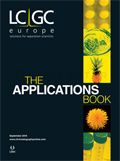Fast Antibody Titer Analysis with a New Protein A Column
The Application Notebook
Antibody related biopharmaceuticals represent one of the most dynamic segments of the pharmaceutical market. The analysis and monitoring of product titers in CHO cell cultures is one of the key tasks during development of new products. Cell line selection, optimization of expression rates, and process control need fast and efficient antibody quantification. Besides ELISA assays with known limitations with regard to reproducibility and precision, high performance liquid chromatography (HPLC) analysis using affinity chromatography is applied. This application note summarizes some performance data of a new Protein A affinity column for mAb titer analysis.
Regina Römling, Tosoh Bioscience GmbH
Antibody related biopharmaceuticals represent one of the most dynamic segments of the pharmaceutical market. The analysis and monitoring of product titers in CHO cell cultures is one of the key tasks during development of new products. Cell line selection, optimization of expression rates, and process control need fast and efficient antibody quantification. Besides ELISA assays with known limitations with regard to reproducibility and precision, high performance liquid chromatography (HPLC) analysis using affinity chromatography is applied. This application note summarizes some performance data of a new Protein A affinity column for mAb titer analysis.
Protein A chromatography has become a widely used platform in monoclonal antibody (mAb) purification. Protein A specifically interacts with the Fc part of the human immunoglobulin G (IgG) subclasses IgG1, IgG2, IgG4, and other mammalian derived Ig. This interaction can also be exploited in HPLC to develop a fast determination of mAb concentrations. TSKgel Protein A-5PW is a high performance affinity chromatography column specifically designed for fast and accurate determination of mAb concentration. An optimized, recombinant Protein A ligand is bound to the proven matrix of TSKgel PW. The column provides an extremely wide dynamic range from 0.0125 to 150 g/L.This allows equally accurate determination of comparatively low mAb titers in early development and high mAb titers of optimized cell lines in production.
Material and Methods
Column: TSKgel Protein A-5PW: 4.6 mm × 3.5 cm (PEEK)
Mobile phase: A (Binding buffer): 20 mmol/L sodium phosphate buffer, pH 7.4
B (Elution buffer): 20 mmol/L sodium phosphate buffer, pH 2.5
Flow rate: 2 mL/min
Injection volume: 20 µL
Samples: CHO cell culture supernatant spiked with polyclonal IgG (0.5 g/L)
CHO cell culture supernatant containing monoclonal IgG (0.5–5.0 g/L)
Detection: UV @ 280nm
Gradient: 0–0.5min 0%B; 0.5–1.1 min 100%B; 1.1–2.0 min 0%B
Figure 1 shows the analysis of a mAb spiked to a cell supernatant within 2 min. Host cell proteins and other impurities directly flow through while the IgG is retained. Switching to low pH buffer elutes the antibody fraction in a sharp peak. Staggered injections or increased flow rates of up to 4 mL/min further reduce the analysis time to less than 1 min.
Figure 1: Analysis of Chinese Hamster Ovary (CHO) cell culture supernatant spiked with polyclonal IgG.

The broad dynamic range of the column is shown in Figure 2. Based on a very high binding capacity, the upper limit of calibration allows direct injection of a high titer supernatant without dilution.
Figure 2: CHO cell culture supernatant containing 0.5-5.0 g/L monoclonal IgG.

Conclusion
TSKgel rProtein A-5PW is very well suited for the determination of antibody titers in cell culture supernatant. Its wide dynamic range allows detection of tiny amounts of antibodies (LOQ [S/N = 10]: 46 ng). At the same time it can be used to quantify enormous titers that might be reached in the future. With the ability to perform more than 2000 injections per column, this new affinity column provides an extremely robust method for mAb titer analysis at every stage of the development of recombinant antibodies.

Tosoh Bioscience GmbH
Im Leuschnerpark 4 64347 Griesheim, Darmstadt, Germany
Tel: +49 6155 7043700 Fax: +49 6155 8357900
E-mail: info.tbg@tosoh.com
Website: www.tosohbioscience.de

Determining Enhanced Sensitivity to Odors due to Anxiety-Associated Chemosignals with GC
May 8th 2025Based on their hypothesis that smelling anxiety chemosignals can, like visual anxiety induction, lead to an increase in odor sensitivity, a joint study between the University of Erlangen-Nuremberg (Erlangen, Germany) and the Fraunhofer Institute for Process Engineering and Packaging (Freising, Germany) combined behavioral experiments, odor profile analysis by a trained panel, and instrumental analysis of odorants (gas chromatography-olfactometry) and volatiles (gas chromatography-mass spectrometry).
Investigating 3D-Printable Stationary Phases in Liquid Chromatography
May 7th 20253D printing technology has potential in chromatography, but a major challenge is developing materials with both high porosity and robust mechanical properties. Recently, scientists compared the separation performances of eight different 3D printable stationary phases.
Detecting Hyper-Fast Chromatographic Peaks Using Ion Mobility Spectrometry
May 6th 2025Ion mobility spectrometers can detect trace compounds quickly, though they can face various issues with detecting certain peaks. University of Hannover scientists created a new system for resolving hyper-fast gas chromatography (GC) peaks.

.png&w=3840&q=75)

.png&w=3840&q=75)



.png&w=3840&q=75)



.png&w=3840&q=75)











